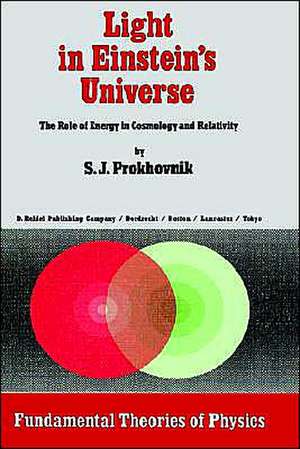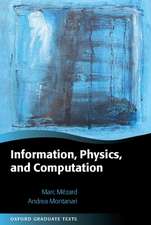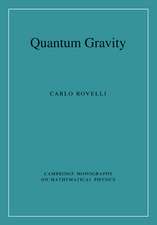Light in Einstein’s Universe: The Role of Energy in Cosmology and Relativity: Fundamental Theories of Physics, cartea 16
Autor R. Prokhovniken Limba Engleză Hardback – 30 sep 1985
| Toate formatele și edițiile | Preț | Express |
|---|---|---|
| Paperback (1) | 637.59 lei 6-8 săpt. | |
| SPRINGER NETHERLANDS – 2 oct 2011 | 637.59 lei 6-8 săpt. | |
| Hardback (1) | 643.84 lei 6-8 săpt. | |
| SPRINGER NETHERLANDS – 30 sep 1985 | 643.84 lei 6-8 săpt. |
Din seria Fundamental Theories of Physics
- 20%
 Preț: 1002.37 lei
Preț: 1002.37 lei -
 Preț: 426.56 lei
Preț: 426.56 lei - 20%
 Preț: 819.48 lei
Preț: 819.48 lei - 18%
 Preț: 779.26 lei
Preț: 779.26 lei - 18%
 Preț: 955.25 lei
Preț: 955.25 lei - 18%
 Preț: 950.52 lei
Preț: 950.52 lei - 24%
 Preț: 794.89 lei
Preț: 794.89 lei - 18%
 Preț: 948.47 lei
Preț: 948.47 lei - 15%
 Preț: 589.80 lei
Preț: 589.80 lei - 18%
 Preț: 1229.73 lei
Preț: 1229.73 lei - 15%
 Preț: 587.83 lei
Preț: 587.83 lei - 18%
 Preț: 1236.06 lei
Preț: 1236.06 lei - 18%
 Preț: 946.87 lei
Preț: 946.87 lei -
 Preț: 394.87 lei
Preț: 394.87 lei - 18%
 Preț: 954.93 lei
Preț: 954.93 lei - 18%
 Preț: 1241.10 lei
Preț: 1241.10 lei - 18%
 Preț: 954.93 lei
Preț: 954.93 lei - 18%
 Preț: 953.35 lei
Preț: 953.35 lei - 18%
 Preț: 948.92 lei
Preț: 948.92 lei - 15%
 Preț: 648.05 lei
Preț: 648.05 lei - 18%
 Preț: 1232.09 lei
Preț: 1232.09 lei - 18%
 Preț: 996.78 lei
Preț: 996.78 lei - 18%
 Preț: 946.41 lei
Preț: 946.41 lei - 15%
 Preț: 640.24 lei
Preț: 640.24 lei - 15%
 Preț: 636.80 lei
Preț: 636.80 lei -
 Preț: 391.79 lei
Preț: 391.79 lei - 18%
 Preț: 780.19 lei
Preț: 780.19 lei -
 Preț: 391.79 lei
Preț: 391.79 lei - 15%
 Preț: 649.06 lei
Preț: 649.06 lei -
 Preț: 397.76 lei
Preț: 397.76 lei - 24%
 Preț: 586.69 lei
Preț: 586.69 lei - 15%
 Preț: 644.95 lei
Preț: 644.95 lei - 18%
 Preț: 1228.15 lei
Preț: 1228.15 lei
Preț: 643.84 lei
Preț vechi: 757.46 lei
-15% Nou
Puncte Express: 966
Preț estimativ în valută:
123.21€ • 127.30$ • 102.49£
123.21€ • 127.30$ • 102.49£
Carte tipărită la comandă
Livrare economică 20 martie-03 aprilie
Preluare comenzi: 021 569.72.76
Specificații
ISBN-13: 9789027720931
ISBN-10: 9027720932
Pagini: 240
Ilustrații: XIV, 222 p.
Dimensiuni: 155 x 235 x 19 mm
Greutate: 0.51 kg
Ediția:1985
Editura: SPRINGER NETHERLANDS
Colecția Springer
Seria Fundamental Theories of Physics
Locul publicării:Dordrecht, Netherlands
ISBN-10: 9027720932
Pagini: 240
Ilustrații: XIV, 222 p.
Dimensiuni: 155 x 235 x 19 mm
Greutate: 0.51 kg
Ediția:1985
Editura: SPRINGER NETHERLANDS
Colecția Springer
Seria Fundamental Theories of Physics
Locul publicării:Dordrecht, Netherlands
Public țintă
ResearchCuprins
1. The Observable Universe.- 1.1 Introduction.- 1.2 The Origins of Modern Cosmology.- 1.3 The Scale of the Universe.- 1.4 The Large-scale Features of the Universe.- 1.5 Recent Observational Developments.- 1.6 Strange and Wonderful Objects.- Exercises and Problems.- 2. The Bases of Modern Cosmology.- 2.1 The Significance of the Hubble Law.- 2.2 The Interpretation of Cosmological Red-Shifts.- 2.3 The Nature of a Mathematical Model.- 2.4 Basic Assumptions and Definitions.- 2.5 The Case for a Uniform Rate of Expansion.- 2.6 The Puzzle of Light Propagation.- Exercises and Problems.- 3. The Principle of Relativity.- 3.1 Motion According to Galileo.- 3.2 Newton’s System of the World.- 3.3 The Basis of Special Relativity.- 3.4 The Lorentz Transformation and its Implications.- 3.5 The Relativity of Time and Length Observations.- 3.6 The Relativistic Metric.- Exercises and Problems.- 4. Light Propagation in an Expanding Universe.- 4.1 The Cosmological Metric.- 4.2 The Geometry of Light Paths.- 4.3 Astronomical Implications.- 4.4 The Equivalence of Fundamental Observers.- Exercises and Problems.- 5. The Effects of Movement Relative to the Fundamental Frame.- 5.1 The Cosmological Acceleration Field.- 5.2 The Primary Anisotropy Effect.- 5.3 The Retarded Potential Law for ‘Moving’ Bodies.- 5.4 The Effect of Motion on Length and Mass.- Exercises and Problems.- 6. Special Relativity as a Cosmological Theory.- 6.1 The Basic Effects of Anisotropy.- 6.2 Observational Consequences.- 6.3 The Balance of Anisotropy Effects.- 6.4 Some Further Consequences.- Exercises and Problems.- 7. Gravitation in a Unique Universe.- 7.1 A Cosmological Basis for Gravitation.- 7.2 Einstein’s Very General Theory.- 7.3 Fock’s Particular Formulation of General Relativity.- 7.4 The Universe as aMass-Energy System.- Exercises and Problems.- 8. The Space, time and Matter of our Universe.- 8.1 Relative or Absolute?.- 8.2 The Status of the Cosmological Substratum.- 8.3 The Nature of Time.- 8.4 The Matter of our Universe.- 8.5 The Essence and Basis of the Argument.- Exercise and Problems.- Appendices.- Appendix 1: The Steady State Syndrome.- Appendix 2: The Status of Einstein’s Stationary System.- Appendix 3: The Black Hole Deduction.- Appendix 4: The Lorentz-Equivalence of Fundamental Observers — General Proof.- Appendix 5: Derivation of the Retarded Potential Field Law — General Case.- Appendix 6: Synchronisation of Clocks By Slow Transport.- Appendix 7: The Relativistic Doppler and Aberration Furmulae.- Comments on the Exercises and Problems.- 1–1 Movement relative to the cosmic background radiation?.- 1–2 Newtonian black holes?.- 2–1 Why do some galaxies exhibit blue-shifts?.- 2–2(a) The velocity space of a steady-state universe.- 2–2(b) The velocity space of a uniformly-expanding universe.- 2–3 Observational indicators of cosmic time.- 3–1 The practical significance of Einstein’s measurement conventions.- 3–2 Derivation of a transformation involving Einstein co-ordinate measures.- 3–3 The influence of Einstein’s new approach.- 3–4 The velocities transformation and the conditions for its employment.- 3–5 The invariance of the out-and-return journey result.- 3–6 The invariance of the order of events within a time-like interval.- 4–1 Two-dimensional representations of an expanding reference frame.- 4–2 The composition of recession velocities.- 4–3 The extent of the universe?.- 4–4 The limits of observation?.- 4–5 Are there any fundamental observers in the universe?.- 5–1 The speed of light relative to a movingsystem.- 5–2 Derivation of the retarded potential result for a point directly behind the moving source-body.- 5–3 Derivation of the general length-contraction formula.- 6–1 The observation of length contraction.- 6–2 The time-dilation result for arbitrarily-oriented light-clocks.- 6–3 The puzzle of the balanced lever.- 6–4 The group properties of the Lorentz transformation.- 7–1 The universe as a mass-energy system.- 7–2 A changing universe as the source of gravity?.- 8–1 Eddington’s table.- 8–2 The faces of the Moon.- 8–3 The twin tendencies of evolution and dissolution in our universe.- List of References.
Recenzii
`An original, timely and stimulating book: do not miss it.' Foundations of Physics (1986)














